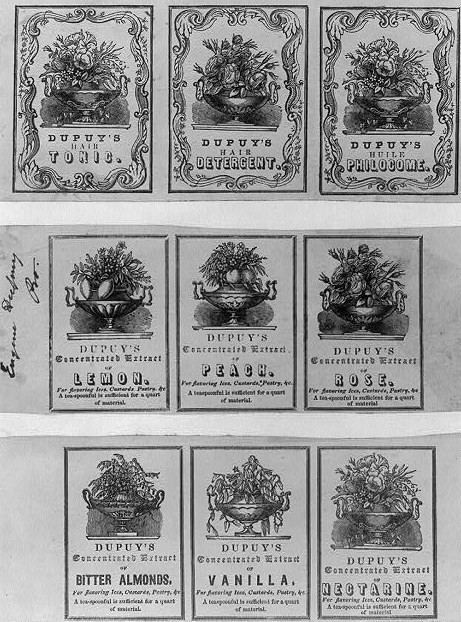Hair conditioner is a hair care product that changes the texture and appearance of hair. Hair conditioner is often a viscous liquid that is applied and massaged into the hair. Hair conditioner is usually used after washing the hair with shampoo. Hair conditioners may contain moisturizers, oils and sunscreen, among other ingredients.
For centuries, natural oils have been used to condition human hair. A conditioner popular with men in the late Victorian era was Macassar Oil, but this product was quite greasy and required pinning a small cloth, known as an antimacassar, to chairs and sofas to keep the upholstery from being damaged by the Macassar Oil.
Modern hair conditioner was created at the turn of the 20th century when perfumer Édouard Pinaud presented a product he called Brilliantine at the 1900 Exposition Universelle in Paris. His product was intended to soften men's hair, including beards and mustaches. Since the invention of Pinaud's early products, modern science has advanced the hair conditioner industry to include those made with silicone, fatty alcohols, and quaternary ammonium compounds. These chemical products have the benefits of hair conditioner without feeling greasy or heavy.
Hair conditioner is different from creme rinse (sometimes spelled "cream rinse"). A creme rinse is simply a "detangler" that has a thinner consistency than conditioner, as its name implies. Hair conditioner is a thicker liquid that coats the cuticle of the hair itself.
Pack conditioners are heavy and thick, with a high content of surfactants that are able to bind to the hair structure and "glue" the hair surface scales together. These are usually applied to the hair for a longer time. The surfactants are based on long, straight aliphatic fatty acid chains similar to saturated fatty acids. Their molecules have a tendency to crystallize easily, giving the conditioner higher viscosity, and they tend to form thicker layers on the hair surface.Leave-in conditioners are thinner and have different surfactants, which add only a little material to the hair. They are based on unsaturated fatty acid chains, which are bent, not straight. This shape makes them less prone to crystallizing, making a lighter, less viscous mixture and providing a significantly thinner layer on the hair. The difference between pack and leave-in conditioners is similar to the difference between fats and oils, the latter being less viscous. Leave-in conditioner is designed to be used in a similar way to hair oil, preventing the tangling of hair and keeping it smooth. Its use is particularly prevalent by those with naturally curly or kinky hair.Ordinary conditioners combine some aspects of pack and leave-in conditioners. Ordinary conditioners are generally applied directly after using shampoo, and manufacturers usually produce a conditioner counterpart for different types of shampoo for this purpose.Hold conditioners, based on cationic polyelectrolyte polymers, hold the hair in a desired shape. These have a function and composition similar to diluted hair gels.There are several types of hair conditioner ingredients, differing in composition and functionality:
Moisturizers, whose role is to hold moisture in the hair. Usually these contain high proportions of humectants. These could also be provided by natural oils such as almond oilReconstructors, usually containing hydrolyzed protein. Their role is supposedly to penetrate the hair and strengthen its structure through polymer crosslinking.Acidifiers, acidity regulators which maintain the conditioner's pH at about 3.5. In contact with acidic environment, the hair's somewhat scaly surface tightens up, as the hydrogen bonds between the keratin molecules are strengthened.Detanglers, which modify the hair surface by pH as acidifiers, or by coating it with polymers, as glossers.Thermal protectors, usually heat-absorbing polymers, shielding the hair against excessive heat, caused by, e.g., blow-drying, curling irons or hot rollers.Glossers, light-reflecting chemicals which bind to the hair surface. Usually polymers, usually silicones, e.g., dimethicone or cyclomethicone.Oils (EFAs - essential fatty acids), which can help dry/porous hair become more soft and pliable. The scalp produces a natural oil called sebum. EFAs are the closest thing to natural sebum (sebum contains EFAs).Surfactants - approximately 97% of hair consists of a protein called keratin. The surface of keratin contains negatively charged amino acids. Hair conditioners therefore usually contain cationic surfactants, which don't wash out completely, because their hydrophilic ends strongly bind to keratin. The hydrophobic ends of the surfactant molecules then act as the new hair surface.Lubricants, such as fatty alcohols, panthenol, dimethicone, etc.Sequestrants, for better function in hard water.Antistatic agentsPreservativesSunscreen, for protection against protein degradation and color loss. Currently benzophenone-4 and ethylhexyl methoxycinnamate are the two sunscreens most commonly used in hair products. Cinnamidopyltrimonium chloride and a few others are used to a much lesser degree. The common sunscreens used on skin are rarely used for hair products due to their texture and weight effects.Conditioners are frequently acidic, as low pH protonates the keratin's amino acids. The hydrogen ions gives the hair a positive charge and creates more hydrogen bonds among the keratin scales, giving the hair a more compact structure. Organic acids such as citric acid are usually used to maintain acidity.

